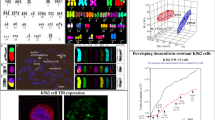Summary
Prior studies have shown a preferential decondensation (or fragmentation) of the heterochromatic long arm of the X chromosome of Chinese hamster ovary cells when treated with carcinogenic crystalline NiS particles (crNiS). In this report, we show that the heterochromatic regions of mouse chromosomes are also more frequently involved in aberrations than euchromatic regions, although the heterochromatin in mouse cells is restricted to centromeric regions. We also present the karyotypic analyses of four cell lines derived from tumors induced by leg muscle injections of crystalline nickel sulfide which have been analyzed to determine whether heterochromatic chromosomal regions are preferentially altered in the transformed genotypes. Common to all cell lines was the presence of minichromosomes, which are acrocentric chromosomes smaller than chromosome 19, normally the smallest chromosome of the mouse karyotype. The minichromosomes were present in a majority of cells of each line although the morphology of this extra chromosome varied significantly among the cell lines. C-banding revealed the presence of centromeric DNA and thus these minichromosomes may be the result of chromosome breaks at or near the centromere. In three of the four lines a marker chromosome could be identified as a rearrangement between two chromosomes. In the fourth cell line a rearranged chromosome was present in only 15% of the cells and was not studied in detail. One of the three major marker chromosomes resulted from a centromeric fusion of chromosome 4 while another appeared to be an interchange involving the centromere of chromosome 2 and possibly the telomeric region of chromosome 17. The third marker chromosome involves a rearrangement between chromosome 4 near the telomeric region and what appears to be the centromeric region of chromosome 19. Thus, in these three major marker chromosomes centromeric heterochromatic DNA is clearly implicated in two of the rearrangements and less clearly in the third. The involvement of centromeric DNA in the formation of even two of four markers is consistent with the previously observed preference in the site of action of crNiS for heterochromatic DNA during the early stages of carcinogenesis.
Similar content being viewed by others
References
Christie NT, Tummolo DM (1987) Alteration of SV40 DNA replication. American Society of Microbiology, Marcos Island, Fla., USA, November, abstr. 55
Christie NT, Cantoni O, Evans RM, Meyn RE, Costa M (1984) Use of mammalian DNA repair-deficient mutants to assess the effects of toxic metal compounds on DNA. Biochem Pharmacol 33:1661–1670
Ciccarelli RB, Hampton TH, Jennette KW (1981) Nickel carbonate induces DNA-protein crosslinks and DNA strand breaks in rat kidney. Cancer Lett 12:349–354
Costa M, Cantoni O, deMars M, Swartzendruber DE (1982) Toxic metals produce an S-phase specific cell cycle block. Res Commun Chem Pathol Pharmacol 38:405–419
Cowell JK (1984) A photographic representation of the variability in the G-banded structure of the chromosomes in the mouse karyotype. Chromosoma 89:294–320
Dalla-Favera R, Bregni M, Erickson J, Paterson D, Gallo RC, Croce CM (1982) Humanc-myc one gene is located on the region of the chromosome 8 that is translocated in Burkitt lymphoma cells. Proc Natl Acad Sci USA 79:7824–7827
Hartwig A, Beyersmann D (1987) Enhancement of UV and chromate mutagenesis by nickel ions in the Chinese hamster HGPRT assay. Toxicol Environ Chem 14:33–42
Heck DJ, Costa M (1982) In vitro assessment of the toxicity of metal compounds II. Mutagenesis. Biol Trace Element Res 4:319–330
Kurita Y, Sugiyama T, Nishizuka Y (1968) Cytogenetic studies on rat leukemia induced by pulse doses of 7,12-dimethylbenz[a]anthracene. Cancer Res 28:1738–1752
Levan G, Levan A (1975) Specific chromosome changes in malignancy. Studies in rat sarcomas induced by two polycyclic hydrocarbons. Hereditas 79:161–198
Levan G, Ahlstrom U, Mitelman F (1974) The specificity of chromosome A2 involvement in DMBA-induced rat sarcomas. Hereditas 77:263–280
Mitelman F (1980) Cytogenetics of experimental neoplasms and non-random chromosome correlations in man. Clin Haematol 9:195–219
Nowell PC (1980) Chromosomes and tumor progression In: McKinnell RG, DiBerardino MA, Blumenfeld M, Bergad RD (eds) Differentiation and neoplasia. Springer, New York Berlin Heidelberg
Nowell PC, Hungerford DA (1960) A minute chromosome in human chronic granulocytic leukemia. Science 132:1197
Pellis NR, Kahan BD (1976) Methods to demonstrate the immunogenicity of soluble tumor-specific transplantation antigens. I. The immunoprophylaxis assay. Methods Cancer Res 13:291–330
Rowley JD (1973) A new consistent chromosomal abnormality in chronic myelogenous leukaemia identified by quinacrine fluorescence and Giemsa staining. Nature 243:290–293
Seabright M (1971) A rapid banding technique for human chromosomes. Lancet II:971–972
Sen P, Costa M (1985) Induction of chromosomal damage in Chinese hamster ovary cells by soluble and particulate nickel compounds: preferential fragmentation of the heterochromatic long arm of the X-chromosome by carcinogenic crystalline NiS particles. Cancer Res 45:2320–2325
Sen P, Conway K, Costa M (1987) Comparison of the localization of chromosome damage induced by calcium chromate and nickel compounds. Cancer Res 47:2142–2147
Sperling K, Kalscheuer V, Neitzel H (1987) Transcriptional activity of constitutive heterochromatin in the mammalMicrotus agrestis (Rodentia, Cricetidae). Exp Cell Res 173:463–472
Sumner AT (1972) A simple technique for demonstrating centromeric heterochromatin. Exp Cell Res 75:304–306
Author information
Authors and Affiliations
Rights and permissions
About this article
Cite this article
Christie, N.T., Sen, P. & Costa, M. Chromosomal alterations in cell lines derived from mouse rhabdomyosarcomas induced by crystalline nickel sulfide. Biol Metals 1, 43–50 (1988). https://doi.org/10.1007/BF01128016
Received:
Issue Date:
DOI: https://doi.org/10.1007/BF01128016



